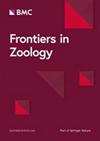Antipredator behaviour as a major determinant of prey altitudinal movements: the wolf and the chamois
IF 2.6
2区 生物学
Q1 ZOOLOGY
引用次数: 0
Abstract
Predators have the potential to affect prey ecology through both direct effects on population dynamics or indirect effects on behaviour, e.g., by triggering antipredator strategies. Direct effects of predation on single prey species may be limited in ecosystems hosting alternative prey, possibly being overwhelmed by indirect effects. The novel exposure to a predator would provide the opportunity to test for immediate prey responses, but information is scanty for areas recolonised by carnivores. We took advantage of the natural expansion of the wolf Canis lupus in a protected area of western Alps hosting five ungulate species to test the potential for direct versus indirect effects on the main prey, i.e., a widespread mountain herbivore (the Northern chamois Rupicapra rupicapra). After verifying the contribution of the latter to the diet of the former, we used a semi-experimental (before vs. after) approach by comparing chamois demography, elevation used and group size between two valleys with different recolonisation time (Site A: medium-term vs. Site B: short-term). Scat analyses (N = 335 samples) indicated that chamois were the staple in the wolf diet in both valleys. Analyses of counts throughout 21 years supported no direct effect of wolf on chamois abundance and survival. Following wolf recolonisation, female chamois (n = 3594 observations) in Site A were observed at average elevations 137 m higher compared to the former period, and a concurrent decrease of group size was reported; these effects were not detected in Site B. The same trend was not observed in temperature, precipitation or NDVI, providing no support to a weather- or resource-mediated uplift. Although direct/indirect effects of current changes in weather patterns on the observed uplift of chamois may not be ruled out, our results suggest antipredator behaviour as a main determinant of chamois upshift. Finally, we discuss the role of indirect versus direct short-term prey responses in complex ecosystems.反捕食者行为是猎物纵向运动的主要决定因素:狼和羚羊
捕食者通过直接影响种群动态或间接影响行为(如触发反捕食者策略)来影响猎物生态。在拥有其他猎物的生态系统中,捕食对单一猎物物种的直接影响可能有限,可能被间接影响所淹没。这种与捕食者的新接触将为测试猎物的即时反应提供机会,但关于食肉动物重新定居的地区的信息很少。我们利用在西阿尔卑斯保护区内有五种有蹄类动物的狼的自然扩张来测试对主要猎物(即广泛分布的山地食草动物(Rupicapra Rupicapra))的直接和间接影响的可能性。在验证了后者对前者的饮食的贡献之后,我们采用了半实验(前后对比)的方法,通过比较两个不同重新定殖时间(地点a:中期与地点B:短期)的山谷间岩羚羊的人口统计、海拔高度和群体规模。粪便分析(N = 335个样本)表明,羚羊是两个山谷狼的主要食物。对21年的统计分析表明,狼对岩羚羊的数量和生存没有直接影响。在狼重新定居之后,A点的雌性岩羚羊(n = 3594只)的平均海拔比前一时期提高了137 m,并且群体规模同时减少;这些影响在b点未被发现,在温度、降水和NDVI中未观察到相同的趋势,因此不支持天气或资源介导的抬升。虽然不能排除当前天气模式变化对观测到的岩羚羊上升的直接/间接影响,但我们的研究结果表明,反捕食者行为是岩羚羊上升的主要决定因素。最后,我们讨论了间接和直接短期猎物反应在复杂生态系统中的作用。
本文章由计算机程序翻译,如有差异,请以英文原文为准。
求助全文
约1分钟内获得全文
求助全文
来源期刊

Frontiers in Zoology
ZOOLOGY-
CiteScore
4.90
自引率
0.00%
发文量
29
审稿时长
>12 weeks
期刊介绍:
Frontiers in Zoology is an open access, peer-reviewed online journal publishing high quality research articles and reviews on all aspects of animal life.
As a biological discipline, zoology has one of the longest histories. Today it occasionally appears as though, due to the rapid expansion of life sciences, zoology has been replaced by more or less independent sub-disciplines amongst which exchange is often sparse. However, the recent advance of molecular methodology into "classical" fields of biology, and the development of theories that can explain phenomena on different levels of organisation, has led to a re-integration of zoological disciplines promoting a broader than usual approach to zoological questions. Zoology has re-emerged as an integrative discipline encompassing the most diverse aspects of animal life, from the level of the gene to the level of the ecosystem.
Frontiers in Zoology is the first open access journal focusing on zoology as a whole. It aims to represent and re-unite the various disciplines that look at animal life from different perspectives and at providing the basis for a comprehensive understanding of zoological phenomena on all levels of analysis. Frontiers in Zoology provides a unique opportunity to publish high quality research and reviews on zoological issues that will be internationally accessible to any reader at no cost.
The journal was initiated and is supported by the Deutsche Zoologische Gesellschaft, one of the largest national zoological societies with more than a century-long tradition in promoting high-level zoological research.
 求助内容:
求助内容: 应助结果提醒方式:
应助结果提醒方式:


